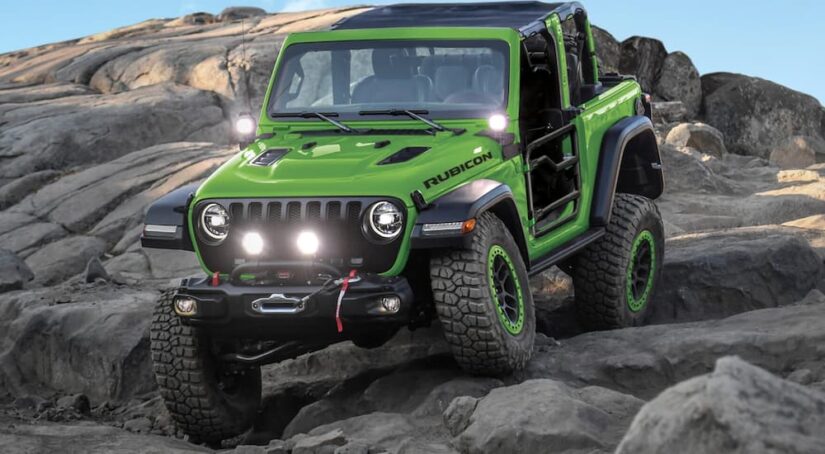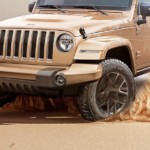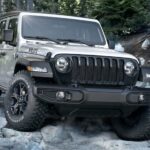If someone told you they are looking for a used Jeep for sale, the odds are you are picturing the iconic model that became the Jeep Wrangler. This is because this vehicle is the one that built the reputation of the Jeep. It has rugged looks unlike any other vehicle on the road today. In an era when so many pickup trucks, sedans, and SUVs are starting to look the same, you usually need to see a hood ornament to tell them all apart. Not so with the Jeep Wrangler. From its distinctive front grille with the vertical slats to its round headlights, you can always tell when a Jeep Wrangler is driving behind you. Its removable doors and roof panels allow it to bring the outdoors inside like no other vehicle. Even its rear, with the full-size spare tire mounted on the tailgate, is a signature of the Jeep Wrangler.
Another thing that has become synonymous with the Jeep Wrangler is its choice of powertrains. This engine and transmission combination has been needed to power this standard 4X4 engineering marvel across decades of driving. This is especially so for drivers who choose a Trail Rated model for off-roading. Let’s see what you can find with a recently used Jeep Wrangler, and then look back at how the engines on this Jeep model developed over the years.
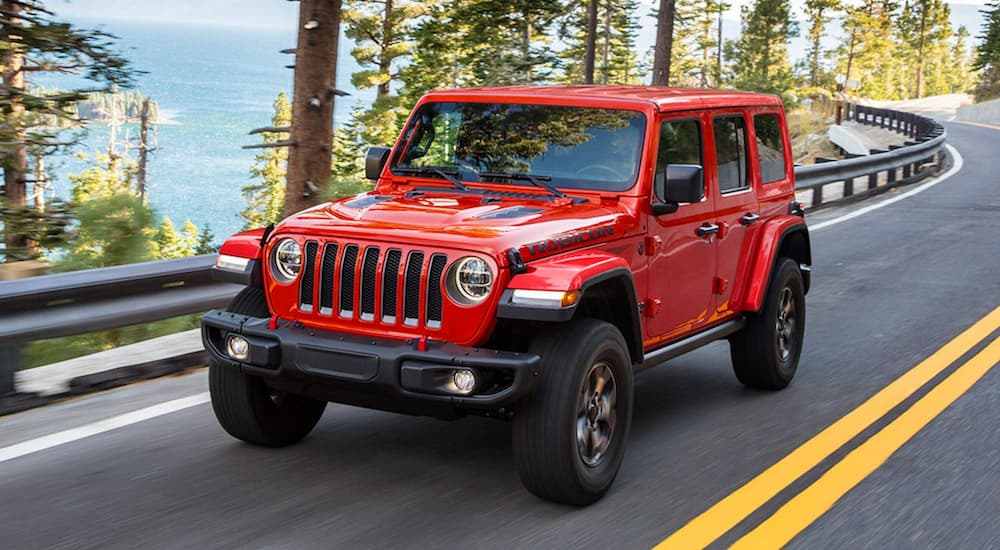
Today’s Models Offer an Array of Engine Options
If you are in the market for a used Jeep, the odds are pretty high that you will be looking at one that was built in the last few years. In 2021, for example, Jeep offered the Wrangler with four different engine options. This is in addition to the hybrid Wrangler 4xe model that premiered that year. The main engine on most 2021 Wranglers is a 2.0-liter Turbo I-4 with an 8-speed automatic transmission. This is the same transmission used on all but one of the engines offered in 2021.
This can deliver up to 270 hp and 295 lb-ft of torque. You can also opt for two versions of a 3.6-liter Pentastar V6 gas engine. One has the eTorque system, which is a mild version of a hybrid. Basically, it replaces the traditional alternator with a belt-driven motor generator. The other doesn’t have eTorque, but instead adds the option of a 6-speed manual transmission as an alternative to the standard 8-speed transmission. Whichever you choose, you get an engine that can give you an impressive 285 hp and 260 lb-ft of torque. Lastly, those who want to harness the power of diesel fuel can opt for the 3.0-liter Ecodiesel V6 that will give you 260 hp and a whopping 442 lb-ft of torque.
Humble Beginnings That Lead to an Impressive Legacy
While Jeep didn’t use the name Wrangler until the debut of the Jeep Wrangler YJ in 1987, you have to go back to the 1940s to see how this model developed. Those first Jeeps may look rudimentary by today’s standards with their simple gas engines and manual transmissions; however, they were rugged, capable, and dependable. This is why the US Army used so many of them during the Second World War. Soldiers knew that when they got behind the wheel of a Jeep, it would get them wherever they needed to go without any problems.
Jeep initially developed these vehicles for military use, but after the war, these vehicles were developed for civilian use. They knew that most passenger cars couldn’t take off-road adventures and would have issues in inclement weather. Seeing an opportunity, Jeep developed a model for the everyday family. This eventually became the Jeep CJ. The first engines were small I-4 and I-6 models matched with a manual transmission. However, by the mid-80s, the Jeep CJ had added larger engines and available automatic transmission to make them more marketable to suburban drivers. By 1985, the Jeep CJ had reached its tenth generation, and the company saw a need for a new Jeep for a new generation.
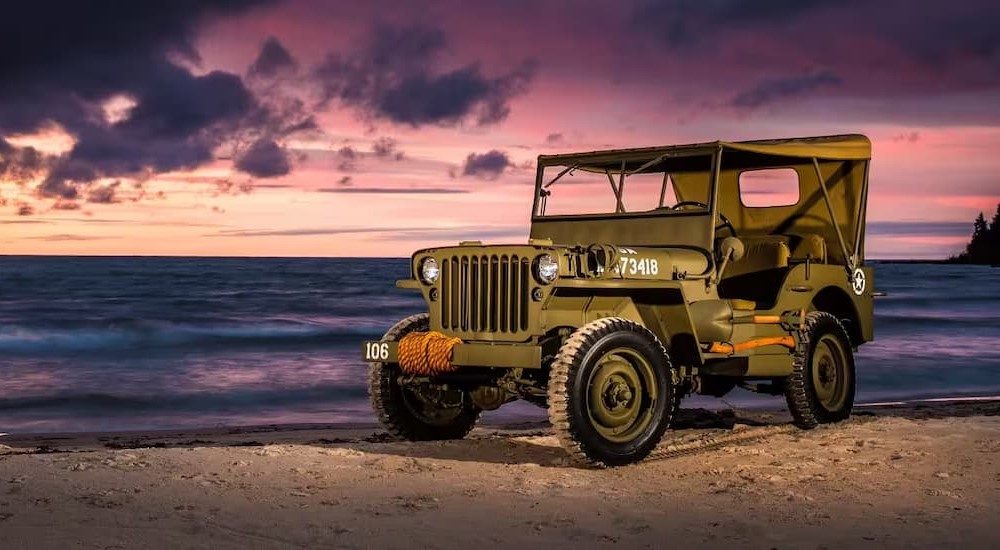
The Birth of the Jeep Wrangler
Jeep unveiled the Jeep Wrangler in 1987 with a wider stance and a pair of square headlights. Fortunately, those square headlights wouldn’t last long and would be replaced by proper round ones later. Designated the YJ, this first Wrangler ran on a 2.5-liter AMC I-4 gas engine as the last year’s model of the Jeep CJ. However, it had been given better overall handling, making it a better choice for most drivers. The second generation Wrangler was designated the TJ and came out in 1997. This model took a major step toward the future. The main engine offered on the 1997 Wrangler was a 4.0-liter I-6 with higher output and better acceleration, signaling a move toward better overall performance in the Jeep Wrangler.
Going Unlimited in the New Millennium
One of the biggest changes for the Jeep Wrangler happened during the second-generation model. Jeep unveiled a new Wrangler Unlimited model with a longer wheelbase in 2004. This gave passengers more legroom in the back of the Jeep and more room for cargo. However, the Jeep Wrangler Unlimited came into its own with the third-generation model. Called the Wrangler JK, this was introduced in 2007 and gave drivers the option of a four-door model called the Wrangler Unlimited. This would become the most popular version of the Wrangler, accounting for over 75% of sales. In addition, the third generation Wrangler features a powerful 3.8-liter V6 gas engine with the choice of a 6-speed manual and 4-speed automatic transmission. This gives the third-generation Wrangler an impressive output of 202 hp and 237 lb-ft of torque.
This engine would remain the workhorse of the third-generation Wrangler until 2012. Jeep decided to make a mid-generation upgrade to the Wrangler, which is quite common for many brands. This smaller 3.6-liter Pentastar V6 gas engine delivers more output than the previous engine. This provides drivers with an impressive 285 hp and 260 lb-ft of torque. Like the previous third-generation powertrain, drivers are given the choice of a manual or automatic transmission.
How We Got Here Today
With the introduction of the fourth generation Wrangler JL model in 2018, Jeep went back to its roots. Where most of the models over the prior twenty years featured a standard engine with a choice of transmission, the fourth generation began offering another choice. Here, Jeep took another page out of its history book, giving drivers the option to choose a smaller, four-cylinder engine. While the 3.6-liter Pentastar V6 was carried over from the third generation, the fourth generation added a 2.0-liter I-4. This comes with automatic transmission only and uses a turbocharger to deliver 268 hp and 295 lb-ft of torque on the 2018 Wrangler model.
Jeep was not done, as it began adding other engines to the Wrangler, including the powerful HEMI V8 on the Wrangler Rubicon 392. But the most efficient engine yet is on the Wrangler 4xe. This pairs a 2.0-liter Turbo I-4 gas engine with a pair of AC synchronous electric motors, one for each axle. This is a plug-in hybrid, meaning you can recharge the lithium-ion battery pack at a public DC fast charging station or in the comfort of your own home. In addition to an impressive output of 375 hp and 470 lb-ft of torque, the powertrain on the Wrangler 4xe has a range of 21 miles on electric power only, with a fuel economy of 49 MPGe in city driving. You can get a piece of the future today in a used Wrangler 4xe or any other Wrangler models built over the last 36 years.
Driving Into the Future With Confidence
While the Wrangler has amazing retro looks that help it stand apart from other vehicles, its powertrains always feature the latest innovations. This is because Jeep understands that it is vital to build for the future while not forgetting the accomplishments of the past. While innovations regarding tech and comfort have also been welcomed by the Jeep Wrangler throughout the years, its exceptional performance has always been at the forefront of every model. After all, the Wrangler was built to explore the unknown, which is precisely what it will continue to do for many years ahead.
